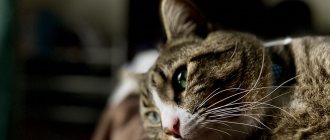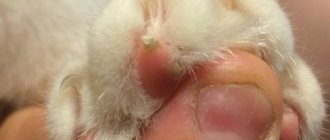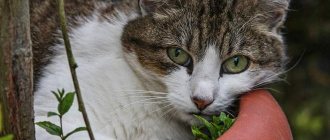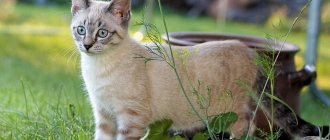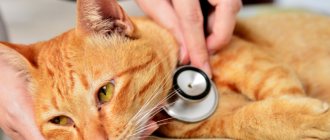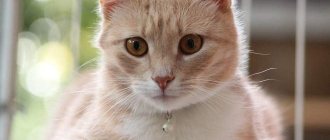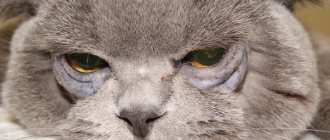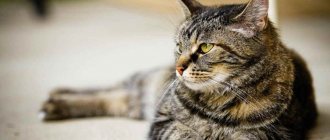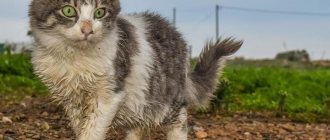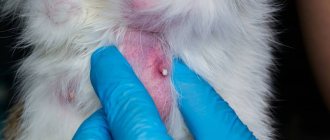Animals, like humans, often suffer from allergic reactions. The pathological condition occurs as a result of various factors, but in the vast majority of clinical cases, an allergy occurs to food. As a result of the penetration of foreign protein components included in cat food into the pet’s body, a response occurs.
The body's defenses recognize the allergen and begin to attack it, thus trying to eliminate it. A specific reaction occurs, manifested by a general discomfort, itching and apathy. The development of the reaction directly depends on the state of the immune system. A weakened animal’s body can perceive even familiar food as dangerous, giving signals in the form of an allergy.
Food allergies
Many people mistakenly assume that if a cat has itching and a rash, it has eaten something wrong. In fact, food allergies are only 10% of all possible allergies. But it is possible. Many pet owners face this problem.
The occurrence of a reaction, in fact, does not depend on how expensive and high-quality food you buy for your cat. Even to special hypoallergenic food, allergic reactions can occur, because it all comes down to the animal’s body. Also, the manifestations do not depend on the sterilization of the animal, its breed, age, or weight.
Quite often, the tendency to allergies is inherited.
Diagnostics
The effectiveness of treatment depends on the accuracy of the examination of the pet. The appearance of skin lesions, bald patches, and frequent itching is a serious reason to visit a veterinarian. Particular attention is paid to the presence of parasites - fleas, lice eaters, ticks; their presence requires additional treatment. To determine the allergen, a method of excluding probable antigens is used.
If an allergic reaction occurs once a year during a certain season, the allergen is not looked for. Seasonal allergies are treated with antihistamines, which should be given until the antigen is completely eliminated.
It should be borne in mind that such a diagnosis and appropriate treatment can only be prescribed by a specialist. After a detailed diagnosis and collection of anamnesis from the owner’s words. Allergies in their symptoms are in many ways similar to infections and inflammation of internal organs.
Allergy to food in cats: when does this phenomenon occur?
The immune system, having encountered a substance that is actually safe, may perceive it as a threat. Then the inflammatory process, which we call allergy, starts. A reaction to food occurs in cases where the cat’s body has detected allergens in the composition.
Allergy to natural food
In most cases, the cause of allergies is protein. Moreover, a reaction to beef or chicken can take a very long time to develop; the allergen will accumulate in the body throughout the year. Eggs, fish and wheat can also cause food allergies.
Allergy to dry food
Allergies most often develop to dry food. It contains many chemical additives, dyes, and flavor enhancers. It contains a high concentration of animal protein, so susceptibility can appear even to expensive and high-quality food.
This allergy develops very quickly, which means it is detected at a fairly early age of the kitten.
Allergy to wet food
Wet food is the least allergenic. It contains a lot of water, which means that fewer irritants enter the body. Allergies to wet food develop more gradually than to dry or natural food. The onset of symptoms is less severe, and it may take a long time before the owner discovers that something is wrong with the animal.
What could be the reaction to (types of allergies)
Allergies in cats can be food or non-food. In the first case, allergens are exclusively food products, and in the second - all remaining factors. That is why the non-edible species contains several subspecies.
For food (food)
Food allergies in cats occur when they consume animal or plant ingredients. Depending on the sensitivity threshold, the reaction may not occur immediately, but after several months of constant consumption of a certain type of food.
When using natural products, veterinarians recommend avoiding chicken. Unscrupulous producers often resort to dangerous antibiotics that accelerate the growth of chickens.
Of course, it is forbidden to give cats spices and food with spices, smoked meats and sweets - these products can cause severe allergies or develop an eating disorder.
For flowering and chemicals (chemical)
In case of non-food type of pathology, allergens are plant pollen and chemicals: cosmetics, household chemicals, tobacco smoke, cat litter. In the first case, symptoms manifest themselves seasonally, and in the second they can be observed constantly.
For insect bites (parasitic-insect)
The most common cause of the disease is bites of blood-sucking parasites (fleas, ticks, lice eaters). When sucking cat blood, the parasites inject their saliva, which contains a protein foreign to the body of the furry pet. It is this that causes a protective reaction from the body.
Autoimmune (atopic)
It is recognized as the rarest species and provokes the development of allergic dermatitis. Appears during an abnormal response from the immune system. The body begins to mistake its own cells for allergens and destroys them.
Allergy to food or food intolerance: how to distinguish between these pathologies
Food intolerance and food allergy are often confused because both pathologies are caused by the animal's diet. However, it is important to distinguish between them, because the future health of the animal depends on the correct treatment.
With allergies, the main symptoms occur on the pet's skin, while with food intolerance, problems with the gastrointestinal tract are observed. Food intolerance does not appear from the allergenicity of the product, but most often from its quantity. With this disease, the body simply cannot digest certain foods because it does not have the necessary enzymes.
Hypoallergenic food
Hypoallergenic food, like all industrial food, is divided into classes according to its composition, with the exception that economy-class food cannot be hypoallergenic.
There are:
- Holistics are the closest food to a cat’s natural optimal diet. Only high-quality natural products, accounting for 70–95% of the total volume, are used as a source of protein. Some holistic foods contain beans, lentils or brown rice as sources of fiber to stimulate intestinal motility, up to 10% of these. Cheap grain fillers, such as corn or wheat, are always unavailable. Vitamins and minerals are also found in natural foods; holistic foods contain berries, herbs, fruits and vegetables. Feeds in this class are the best choice;
- super premium class - also high-quality and complete food. May contain grains in small quantities. Does not contain toxic dyes or preservatives. They consist of high-quality ingredients and are easily digestible;
- premium class - food of average quality, the composition includes grains, protein sources are represented by cheap raw materials of acceptable quality - chicken and by-products. Contains safe chemical preservatives that do not pose a threat to your pet's health. Despite the fact that these feeds are complete, experienced breeders do not use them on an ongoing basis, preferring feeds of higher classes or natural nutrition.
Based on their composition, hypoallergenic foods are divided into formulations with limitations:
- vegetable protein (gluten) - do not contain corn or wheat. May contain oats, millet or rice;
- common sources of animal protein - rabbit, duck, lamb, salmon are used in preparation, to which allergies are very rare due to the low prevalence of these products in everyday nutrition. Some manufacturers produce food with completely exotic protein sources, for example, kangaroo or elk meat;
- products made from milk, yeast, eggs - these foods are marked with a message indicating the limitation of the composition.
Some manufacturers minimize the occurrence of allergies by excluding foods from several risk groups from their feed.
Hypoallergenic food is produced in a wide range by different manufacturers, allowing you to choose the right nutrition for each pet suffering from food allergies.
Brit Care
These feeds are produced in the Czech Republic and belong to the super premium class. Contains essential vitamins, minerals, biological active substances. They are presented in a wide range, taking into account the needs of pets of different ages and breeds, as well as lifestyles. The main sources of protein in most feeds are:
- dehydrated chicken and its fillet;
- for pets kept on the streets, venison is additionally included,
- for long-haired breeds - salmon meal and its meat,
- for pets with sensitive digestion, salmon and lamb flour serves as a source of protein;
- obese - turkey;
- for large breeds - dried duck,
- for picky pets with sensitive digestion - duck and salmon meat.
Rice serves as a source of carbohydrates; fats - chicken fat and salmon oil; fiber is represented by apples, rice bran, and in some feeds - beet pulp or yellow peas.
There are very few by-products - no more than 2% chicken liver. Additionally, they contain sea buckthorn and Yucca Schidigera extract, which has a beneficial effect on digestion in the form of improving peristalsis, reducing inflammatory processes, and also reducing urease, which reduces the release of ammonia, thus reducing the load on the liver when absorbing protein components, and also reducing the smell of urine and excrement . The food is enriched with glucosamine and chondroitin sulfate, essential for healthy joints. Additionally, vitamins and microelements were introduced in the form of functional additives. The composition of the feed is completely transparent. The preservatives appear to be tocopherol (vitamin E) and sodium hexametaphosphate, which are also widely used in human products.
The composition of the food seems to be of high quality, and the manufacturer seems conscientious, but, in my opinion, these foods are more suitable for preventing the development of allergies or for a pet with already established food allergens, rather than for an elimination diet, since chicken and yeast cause allergies quite often, also the presence containing proteins from different sources may make diagnosis difficult.
The food line includes:
- Brit Care Crazy - for kittens up to one year;
- Brit Care Cat Lucky - for adult cats with chicken and rice;
- Brit Care Cat Angel - for senior cats over 7 years old, with chicken and rice;
- Brit Care Cat Cheeky - for outdoor cats, with venison and rice;
- Brit Care Cat Monty - for indoor cats, with chicken and rice;
- Brit Care Cat Sunny - for cats whose fur requires extra care, with salmon and rice;
- Brit Care Cat Lilly - for cats with sensitive digestion with lamb and salmon;
- Brit Care Cat Missy - for sterilized cats, with chicken, turkey and rice;
- Brit Care Cat Daisy - food for overweight cats with turkey and rice;
- Brit Care Cat Cocco - for picky cats with sensitive digestion, with salmon and duck;
- Brit Care Cat Tobby - for large breed cats, with duck and chicken.
Cat food from the Brit Care line belongs to the super-premium class and is presented in a wide range
The manufacturer also produces spiders and canned food, which can be used to diversify a cat’s diet from time to time, but these types of food are not suitable for constant nutrition, since such forms of release do not allow them to contain a complete composition. The approximate price is 978 rubles for 2 kg of dry food, 88 rubles for 80 grams of canned food and 68 rubles for 80 grams of food in a pouch.
Pro Plan Veterinary diets HA Hypoallergenic and Cat Chow Adult Sensitive from Purina
Pro Plan Veterinary diets HA Hypoallergenic is a premium food that contains a single source of protein - soybean hydrolysate. The use of hydrolysates is safe in allergic cats, since the immune system does not react to protein molecules weighing no more than 10 kDa. The food is enriched with polyunsaturated fatty acids, which reduce inflammatory reactions and have a beneficial effect on the condition of the skin and coat. Additionally, the manufacturer recommends using the food for:
- colitis and enteritis;
- food intolerance;
- deficiency of digestive enzymes of the pancreas, which occurs with chronic pancreatitis;
- increased levels of lipids in the blood;
- absorption disorders;
- intestinal diseases accompanied by protein loss.
Among the ingredients, corn starch comes first, and soy hydrolysate comes second. Also contains coconut, rapeseed and soybean oil, fish oil. Additionally, a complex of vitamins and microelements has been introduced. The composition is opaque. It is not suitable for constant feeding of a pet; it can be used for an elimination diet. There are no wet analogues of this food.
Cat Chow Adult Sensitive with high salmon content - belongs to economy class. The composition of the feed is opaque; whole grains are listed in the first place (40%), meat and processed products are listed in the second place (20%). Fish and its processed products are listed only in fifth place. The composition is not detailed, and the quality of the ingredients is therefore of great concern. No one should feed them. There is no wet analogue.
The approximate cost of Pro Plan Veterinary diets HA Hypoallergenic is 1320 rubles per 1.3 kg; Cat Chow Adult Sensitive - 527 rubles per 1.5 kg.
Pro Plan dry hypoallergenic food is based on a single protein source and is therefore suitable for an elimination diet
Hypoallergenic DR25, Sensitivity Control SC27 and Anallergenic AN24 from Royal Canin
Hypoallergenic DR25 food is a premium class food with soy hydrolysate as the only source of protein. Enriched with vitamins, minerals, polyunsaturated fatty acids and prebiotics. The first ingredient is rice. The source of animal fats is not detailed. Beet pulp is a source of fiber. The manufacturer indicates a reduction in the risk of formation of struvite and oxalate urinary stones when using a diet, and additionally recommends using the food for:
- food intolerance;
- colitis and enteritis;
- intestinal dysbiosis;
- chronic diarrhea and constipation.
The food is suitable for use during an elimination diet.
Sensitivity Control SC27 food also belongs to the premium class, the first ingredient is rice, the second is dehydrated duck protein, the sources of animal fats and fiber are not detailed. The food is enriched with polyunsaturated fatty acids and a complex of vitamins and microelements that improve the condition of the skin and coat. The manufacturer, in addition to allergies, suggests using the food for food intolerance and diarrhea in adult cats.
Anallergenic AN24 food is designed specifically for cats with severe hypersensitivity due to food allergies. The source of protein is high-quality feather hydrolyzate, with corn starch listed first in the composition. Enriched with polyunsaturated fatty acids in coconut and soybean oils and fish oil. Sources of animal fats and plant fibers are not disclosed. The food contains vitamins and microelements. The manufacturer recommends its use for:
- adverse reactions to food;
- atopic dermatitis accompanying adverse reactions to food;
- colitis and enteritis.
The food is prohibited for use during pregnancy, as well as during the growth period, probably due to its poor amino acid composition.
There are no wet foods in the hypoallergenic line.
The approximate cost of Hypoallergenic DR25 food is 2399 rubles per 2.5 kg, Sensitivity Control SC27 - 1448 rubles per 1.5 kg, Anallergenic AN24 - 2132 rubles per 2 kg.
Royal Canin Sensitivity Control SC27 dry cat food contains dehydrated duck protein as a protein source
Hill's Prescription Diet Food Sensitivities
Hill's Prescription Diet Food Sensitivities is a premium food, the only source of protein in it is chicken liver hydrolysate, and the only source of carbohydrates is rice. In terms of content, the first place belongs to milled rice, the second place to rice protein. Chicken liver hydrolyzate is only in third place. The origin of animal fats and fiber is not specified. The food contains vitamins, microelements, and polyunsaturated fatty acids.
This food is supplemented with canned food containing hydrolyzed chicken liver and corn starch, as well as soybean oil, vitamins, minerals and taurine.
The approximate cost of dry food is 2150 rubles per 2 kg, canned food - 161 rubles per 156 grams.
Vet Life Cat UltraHypo from Farmina
This food belongs to the premium class; the source of protein is hydrolyzed fish protein, which ranks first in terms of mass fraction in the food, which distinguishes it from the hypoallergenic foods of Hill's, Purina and Royal Canin. The source of carbohydrates is rice starch, and the source of fats is fish oil. The food is additionally enriched with vitamins and microelements, its composition is transparent. Calcium sulfate dihydrate contained in the feed is used both as a stabilizer and as a substance that acidifies urine and prevents the formation of stones. This food is also well suited for an elimination diet and is available only in dry form. The approximate price is 2132 rubles per 2 kg.
Photo gallery: hypoallergenic cat food
Hill's Prescription Diet Food Sensitivities is formulated with chicken liver hydrolysate.
Hill's Prescription Diet Food Sensitivities is also available as a wet food that also contains chicken liver hydrolysate.
Vet Life Cat UltraHypo is made from fish protein
Savarra
The Savarra line of hypoallergenic food belongs to the super premium class. This is Russian food, produced in the UK. The line is represented by products:
- Sensitive Cat - for adult cats with sensitive digestion. Contains 74% meat ingredients, the largest share belongs to fresh lamb meat and dehydrated lamb meat, dihydrogenated salmon meat and eggs are presented as additional sources of protein. Rice and brown rice are sources of carbohydrates. Fats include turkey fat and salmon oil;
- Light/Sterilizied Cat - for overweight or sterilized adult cats. Contains 67% meat ingredients. The source of protein is fresh turkey meat and dehydrated turkey meat, which have the highest specific gravity. Sources of carbohydrates include rice, brown rice and oats. The source of fat is turkey fat;
- Kitten - for kittens, content of meat ingredients 77%. Protein is found in fresh turkey meat and dehydrated turkey meat. Carbohydrates are found in rice, brown rice, and oats. Sources of fat include turkey fat and salmon oil;
- Indoor Cat - for adult cats kept in apartments. Contains 73% meat ingredients, in the first positions there are fresh and dehydrated duck meat as a source of protein; carbohydrates are represented by rice and oats; fats - turkey fat and salmon oil;
- Hairball Control For A Cat - for adult long-haired cats, prevents the formation of pilobesoars - the formation of hairballs in the cat's stomach and intestines. Contains 69% meat ingredients, the source of protein is fresh and dehydrated duck meat. Carbohydrates are found in rice and oats. Fats are found in salmon oil and turkey fat. Adding alfalfa, which is listed as the sixth ingredient, to the main sources of fiber used in all foods helps prevent matting of grooming hair and the formation of pilobesoars;
- Adult Cat - contains 71% meat ingredients. The first positions on the list belong to lamb meat, fresh and dehydrated. Additional sources of protein are salmon meat, located in position 5, as well as dehydrated eggs. Carbohydrates include rice, brown rice and oats. Fats are found in salmon oil and turkey fat.
Sources of fiber include peas, as well as carrots, tomatoes, apples, berries and seaweed included in the food. The food contains brewer's yeast as a source of B vitamins, as well as easily digestible amino acid chelates of metal ions, essential amino acids and vitamins. Including berries in the composition allows you to acidify the urine and avoid the formation of stones. The food is suitable for allergic cats with a diagnosed allergen. Some foods contain chicken eggs and brewer's yeast, which provoke allergies, which must be taken into account. Also, if you use the food on an ongoing basis, you need to understand that in fact there will be less meat ingredients in the finished food, since fresh meat, which is always listed at the top of the rating, loses a lot of weight when cooked, and sources of carbohydrates come out on top. This manufacturer does not offer wet food for cats.
The approximate cost of feed is 1300 rubles per 2 kg.
Savarra hypoallergenic food is available in a wide range for pets with different needs and is well suited for the daily nutrition of cats.
1st Choice Hypoallergenic
This is a Canadian food that belongs to the super premium class. It does not contain grains. The main source of protein is fresh duck meat, which occupies the second position in the list of ingredients; chicken liver hydrolysate and pea protein are indicated as additional sources. Carbohydrates are found in sweet potatoes, which rank first in content, and rice protein. Fats include vegetable oil and salmon oil. Fiber - beet pulp and pea fiber. The composition includes chondroprotectors, vitamins, minerals, trace elements, and essential amino acids as functional additives. This food may be suitable for pets with low protein requirements, especially if they are allergic to gluten. The food is produced only dry, the approximate price is 2290 rubles per 2.72 kg.
"Our Brand" Hypoallergenic
This is Russian economy class food. The source of protein is poultry meal, which ranks second in the list of ingredients, as well as corn gluten, hydrolyzed liver without specifying the species and beef liver. Corn, a source of carbohydrates, has the largest share among the ingredients. Fiber is found in beets, and fats are found in sunflower oil. The composition includes vitamins A, D, E; brewer's yeast and taurine. The vast majority of ingredients are highly likely to be allergens; you should not feed this food to a sick pet. The food costs 477 rubles per 2 kg.
1st Choice Hypoallergenic food does not contain grains, making it suitable for pets with gluten allergies.
Grandorf
These are Belgian holistic food products, presented in both dry and wet food.
Dry food:
- grain-free food with white fish and sweet potato - for adult cats with allergies and skin and coat problems. The first two places in the list of ingredients are occupied by dehydrated cod and herring meat; protein is also found in dehydrated and fresh turkey meat. Carbohydrates are represented by dried sweet potatoes, fats are represented by turkey fat;
- low-grain feed with live probiotics: a feature of these feeds is the content of a live culture of Enterococcus faecium, which restores and maintains intestinal microflora. Contains 70% meat components: 4 types of meat with brown rice for apartment cats. The main sources of protein, occupying the first places in the list of ingredients, are dehydrated turkey, duck and rabbit meat; in fifth place is dehydrated lamb meat, in sixth place is fresh turkey meat. Carbohydrates are found in whole brown rice, fats are found in fresh salmon oil and turkey fat;
- 4 types of meat with brown rice for sterilized pets - the same protein sources are used as in the previous food, the specific content of dehydrated lamb meat and fresh turkey meat is slightly reduced. Carbohydrates include brown rice and dried sweet potatoes. Fats - fresh salmon oil and turkey fat.
- with lamb and rice for kittens - the first two places in the list of ingredients are occupied by dehydrated lamb meat and dehydrated turkey meat; Additionally, the composition includes fresh lamb and turkey meat. Carbohydrates are represented by whole white rice, fats - turkey fat;
Additionally, all foods contain vegetables, fruits, berries and herbs as a source of fiber, vitamins and microelements; sea krill was used as a source of polyunsaturated fatty acids; The composition of each food is supplemented with a complex of natural antioxidants, which also act as preservatives. Brewer's yeast, which is potentially allergenic and is used as a source of B vitamins, may raise questions. The protein components that come first in the feed are represented by dehydrated meat, which means that its high specific gravity will remain in the finished feed. The feed contains exclusively high-quality ingredients, with the exception of brewer's yeast, which do not provoke the development of allergic reactions. These foods are best suited for regular feeding of pets with allergies.
The Grandorf food line is complemented by a wide range of canned foods, which are all-natural meat, fish ingredients or seafood in their own juice. Grandorf canned food does not contain grains, is made from tuna fillet or chicken breast, and can be used to diversify a cat’s diet. Canned food is distinguished by its simplicity and transparency of composition, which allows you to make a safe choice for an allergic pet.
The cost of dry food is 400–420 rubles per 400 grams, canned food is 90 rubles per 70 grams.
Grandorf food belongs to the holistic class; among them you can choose food for both a pet with an allergy to protein and gluten
How do food allergies manifest in cats?
Many people mistakenly believe that a skin rash appears as a result of the allergic reaction itself, but it indicates a secondary phenomenon - bacterial inflammation. And the symptoms of the allergy itself are itching, hair loss, blisters, nasal discharge and even vomiting with diarrhea, with prolonged exposure to the allergen.
If your pet is allergic to dry food, then you can pay attention to the fact that the cat begins to sneeze heavily while sniffing the granules. There may also be itching in the nose and eyes, which over time spreads to the whole body.
If you ignore the symptoms, small wounds will soon begin to appear on your cat’s skin, and in the future, eczema. In the photos of sick animals you can see that food allergies are characterized by skin damage in the head and neck area.
Symptoms
Allergies can occur differently each time, it all depends on the cause of its occurrence. So, for example, the food form is accompanied by damage to the digestive tract - bloating occurs, appetite disappears, and the pet suffers from constipation or diarrhea. Insect bites negatively affect the condition of the skin; the pet experiences eosinophilic allergic syndrome - the appearance of foci of infections on the skin.
In most cases, skin lesions in a pet directly depend on the presence of an allergic reaction. Characterized by redness, the appearance of blisters, rashes and itching. The progression of the affected areas leads to restless behavior of the pet - licking and scratching the sore spot. This leads to deterioration of the skin condition. There is a risk of secondary infection; the source of irritation becomes covered with purulent plaque and causes swelling of the surrounding tissues.
There are several types of skin lesions:
- Eosinophilic plaque. The most common form can occur due to any irritant - an unbalanced diet, pest bites, etc. Characterized by the appearance of spots that protrude slightly above the surface of the skin. These manifestations are hyperemic and separated by clear boundaries. Sometimes the surface of the lesion may be moist, its size varies from 0.5 to 5 cm. Most often, the lesion is located on the inner thighs and abdomen.
- Ulcer. Characteristic of food allergies, but not excluded in case of bites and contact with chemicals, it is expressed by ulcerative lesions. The size of the ulcer varies from 5 mm to 5 cm. Sometimes it is accompanied by itching and pain. Mainly located on the inner surface of the cheeks and lips, often symmetrically on both sides.
When determining the diagnosis, it is important to take into account that ulcers can also occur in the presence of injuries and other diseases. Even feeding hard, dry food can damage the mucous membrane, especially in young and elderly animals.
- Allergic billion dermatitis. The main pathogens are fleas, ticks, and ectoparasites. But at the same time, it is possible that it may appear with a rich protein or dairy diet. It is characterized by a rash on the skin in the form of papules covered with a crust. Inflamed areas are located in the back, neck and inner thighs. Long-term progression of the disease leads to the appearance of pigment spots.
- Eosinophilic granuloma. Characteristic of all forms of allergies. It appears in the form of a linear plaque of a yellowish color, can be located on the lower lip, in the form of swelling or on the body - accompanied by itching. Before starting treatment, you should examine the surface of your pet’s skin for neoplasms, including infectious granulomas.
How to find out what causes cat food allergies
It is very difficult to find out which allergen causes such a reaction. Even more difficult is to remove it from the diet. Therefore, the best option would be to go to a specialist in the clinic as soon as symptoms are identified.
You should not self-medicate, because symptoms similar to food allergies appear in atopic dermatitis and some other diseases.
To determine which product your pet is allergic to, an elimination diet is used. All nutritional components in it are replaced with hypoallergenic ones, and special food is purchased. As soon as the allergy symptoms go away, the diet is changed to a provoking one - elements are introduced one at a time and the body's reaction is monitored. This is a very time-consuming detection method, but, alas, there is no other method.
It is very important to carefully monitor that during these diets the cat does not receive additional nutrition, which can confuse the clinical picture.
Treatment of food allergies
There is no remedy that will definitely help against allergies. How to treat it in this case? After detecting the substance that caused the reaction, the animal must be given help. To treat the allergy itself, the allergen that caused it is simply excluded from the diet.
Relieving symptoms is another matter, because itching and ulcers on the skin can torment your pet for a long time. To eliminate symptoms, the doctor prescribes special medications at his discretion.
Treatment cannot be started before the allergen has been identified: in this case, it is unclear whether the product was removed from the diet, or whether the medications taken had an effect.
Treatment and health maintenance
Treatment of allergies in a cat involves isolation from allergens, eliminating existing symptoms and preventing the appearance of new signs. Depending on the cause and form of the disease, dietary adjustments and drug therapy may be required.
Eliminating the allergen
A cat's allergy to food can be treated by taking a hypoallergenic analogue for 3 months. After the symptoms are eliminated, the previous diet is gradually returned. If an allergic reaction to one of the products occurs, the treatment is repeated. All allergenic foods are permanently removed from the diet.
During flowering, it is recommended to avoid walking outside and increase the frequency of bathing. This will help wash away pollen from the fur that enters the house through the windows. An anti-cat net is useful as a preventive measure: this net will not only protect against animal falls, but will also reduce the number of allergens in the house.
To protect against parasites, regular cleaning of the premises and timely treatment of the pet is recommended. If you react to chemicals, you will have to abandon your usual shampoos in favor of hypoallergenic ones and avoid the use of aerosol sprays. Wash the floor without household chemicals and keep all hazardous substances away from your furry pet.
What medications will the doctor recommend?
The main drugs for treating allergies in cats include antihistamines (Claritin, Cyprodin, Diphenhydramine, Cetirizine) and glucocorticosteroids (Prednisolone, Dexafort). These medicines are sold in a human pharmacy. The former suppress the activity of histamine, while the latter reduce the sensitivity of immune cells and inhibit the production of antibodies. Most of them are not veterinary drugs, so the brand and dosage must be agreed with your veterinarian. It is not safe to use tablets and injection solutions according to instructions developed for humans.
When using most antihistamines, the pet becomes drowsy and lethargic. This is not dangerous for his health - his condition stabilizes soon after the end of the course of treatment.
Steroid allergy medications for cats have many contraindications. They are prescribed for bronchial asthma, severe symptoms or unsuccessful treatment with antihistamines. Chronic use of these drugs is dangerous for the development of kidney failure, diabetes and other complications. An alternative treatment is to use an inhaler. The medicine inhaled during inhalation does not accumulate in the gastrointestinal tract and blood. Systemic interaction on the body is excluded.
Nutrition correction and special feeds
If the allergen is food, the animal is prescribed specialized hypoallergenic food containing hydrolyzed protein. During production, it is broken down to the level of amino acids, which eliminates subsequent negative reactions from the body. Treatment of allergies in cats with a diet lasts at least 3 months and excludes any products other than the food prescribed by the veterinarian. Favorite treats and wet food are also prohibited.
To eliminate symptoms, it is recommended to enrich the diet with Omega-3 fatty acids and Biotin, a B vitamin. When used in combination, they help restore damaged skin. Drugs and dosages are selected individually by the veterinarian.
Relieving itching and scratching
In addition to Biotin, Gistane or Cyclosporine are suitable for healing damaged skin. They will help relieve itching and swelling, and also eliminate inflammation. To dry weeping ulcers, use zinc ointment or medical talc.
If parasites are present, it is recommended to treat with acaricidal preparations and wash with medicated hypoallergenic shampoos. After destroying the pathogens, treat the scratches regularly to prevent re-infection. Hydrocortisone ointment is suitable for this.
Features of kitten treatment
How to treat allergies in cats under 1 year of age, especially in kittens? Most drugs are unsafe for children due to possible contraindications.
Kittens are treated with an elimination diet lasting no more than a week. The diet is based on one type of animal protein and any plant component. The number of products is gradually expanded until the first deterioration in the body.
Among antihistamines, Tavegil is used with a lower dosage. The affected areas of the skin are treated with hydrocortisone ointment, that is, in the same way as for adult animals.
